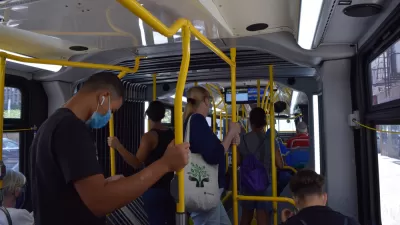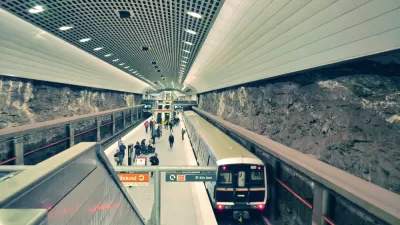Agencies can use data resources to improve their decision-making and provide more responsive service.

With transit ridership "still down about 54 percent from where it was at this time in 2019," transit agencies are turning to data and technology to explore ways to change their operations and better serve riders, writes Skip Descant.
"New Jersey Transit is partnering with the movement technology firm Replica to fold a number of data resources into planning and decision-making at the agency. The Replica data reflects localized economic activity, ridership changes on any given route, and a look at the overall mobility in an area showing not only the mode of travel, but also the purpose of the trip." Elsewhere, "the Utah Transit Authority in Salt Lake City is joining forces with community partners to offer on-demand rides for late-night workers," and "[t]he San Francisco Municipal Transportation Agency has installed temporary transit lanes on key routes 'to speed up service so that transit riders do not bear the cost of traffic congestion.'"
"In order to be resilient, transit has shown a need to think and act fast. Which is where data, and its analysis, can help," Steven Turell, chief of staff for Replica, told Government Technology. Using data, "you can actually start to optimize much more quickly for the outcomes that you want in the city."
FULL STORY: Data, Analysis Are Essential to Planning the Future of Transit

Study: Maui’s Plan to Convert Vacation Rentals to Long-Term Housing Could Cause Nearly $1 Billion Economic Loss
The plan would reduce visitor accommodation by 25,% resulting in 1,900 jobs lost.

North Texas Transit Leaders Tout Benefits of TOD for Growing Region
At a summit focused on transit-oriented development, policymakers discussed how North Texas’ expanded light rail system can serve as a tool for economic growth.

Why Should We Subsidize Public Transportation?
Many public transit agencies face financial stress due to rising costs, declining fare revenue, and declining subsidies. Transit advocates must provide a strong business case for increasing public transit funding.

How to Make US Trains Faster
Changes to boarding platforms and a switch to electric trains could improve U.S. passenger rail service without the added cost of high-speed rail.

Columbia’s Revitalized ‘Loop’ Is a Hub for Local Entrepreneurs
A focus on small businesses is helping a commercial corridor in Columbia, Missouri thrive.

Invasive Insect Threatens Minnesota’s Ash Forests
The Emerald Ash Borer is a rapidly spreading invasive pest threatening Minnesota’s ash trees, and homeowners are encouraged to plant diverse replacement species, avoid moving ash firewood, and monitor for signs of infestation.
Urban Design for Planners 1: Software Tools
This six-course series explores essential urban design concepts using open source software and equips planners with the tools they need to participate fully in the urban design process.
Planning for Universal Design
Learn the tools for implementing Universal Design in planning regulations.
Ascent Environmental
Borough of Carlisle
Institute for Housing and Urban Development Studies (IHS)
City of Grandview
Harvard GSD Executive Education
Toledo-Lucas County Plan Commissions
Salt Lake City
NYU Wagner Graduate School of Public Service





























